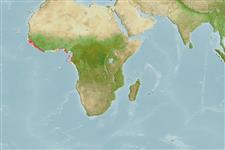>
Perciformes/Bembropoidei (Duckbill flatheads) >
Bembropidae (Duckbill flatheads)
Etymology: Bembrops: Greek, bembras, -ados = a kind of anchovy m+ Greek, ops = appearance (Ref. 45335); cadenati: Species named for J. Cadenat in recognition of his work on marine fishes off western Africa.
Eponymy: Dr Jean Cadenat (1908–1992) of the University of Dakar, was a French researcher and ichthyologist at the ‘Office de la recherche scientifique et technique outre-mer’, where he was Director of the Marine Biological Section of the Institute Français [...] (Ref. 128868), visit book page.
Environment: milieu / climate zone / depth range / distribution range
Ecología
marino demersal; rango de profundidad 120 - 220 m (Ref. 13203). Deep-water
Eastern Atlantic: Guinea, Gulf of Guinea.
Tamaño / Peso / Age
Maturity: Lm ? range ? - ? cm
Max length : 16.4 cm SL macho / no sexado; (Ref. 13203)
Espinas dorsales (total) : 6; Radios blandos dorsales (total) : 15; Radios blandos anales: 18. Color in alcohol yellowish brown dorsally, lighter ventrally. Snout relatively short (1.2x eye diameter). Scales present laterally and dorsally on snout. Upper jaw extending behind anterior margin of eye but not reaching its mid-line. Maxillary tentacle medium-sized, slender. Lateral line descending gradually in posterior third of pectoral fin, separated from origin of first dorsal fin by 4 rows of scales, from origin of anal fin by 7, and from insertion of anal fin by 4. No evidence of prolongation of any spine of first dorsal fin. Predorsal length for first dorsal fin slightly higher than head length. Pectoral fin relatively pointed (Ref 13203).
Life cycle and mating behavior
Madurez | Reproducción | Puesta | Huevos | Fecundidad | Larva
Das, M.K. and J.S. Nelson, 1996. Revision of the percophid genus Bembrops (Actinopterygii: Perciformes). Bull. Mar. Sci. 59(1):9-44. (Ref. 13203)
IUCN Red List Status (Ref. 130435: Version 2024-2)
Threat to humans
Harmless
Human uses
Herramientas
Special reports
Download XML
Fuentes de Internet
Estimates based on models
Preferred temperature (Ref.
123201): 14.4 - 15.4, mean 15.2 °C (based on 5 cells).
Phylogenetic diversity index (Ref.
82804): PD
50 = 0.5000 [Uniqueness, from 0.5 = low to 2.0 = high].
Bayesian length-weight: a=0.00380 (0.00157 - 0.00921), b=3.11 (2.91 - 3.31), in cm total length, based on LWR estimates for this (Sub)family-body shape (Ref.
93245).
Nivel trófico (Ref.
69278): 4.0 ±0.4 se; based on size and trophs of closest relatives
Fishing Vulnerability (Ref.
59153): Low vulnerability (10 of 100).
